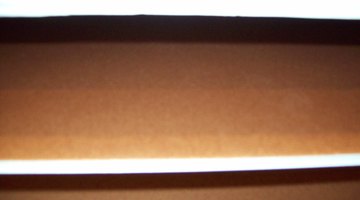Foam boards is a sturdy, easy-to-cut material used for crafting and picture framing. It ranges from 1/8-, 3/16- to ½-inch thick, with 3/16-inch being the most common size. You can usually find white and black board relatively inexpensively at art or craft stores, but other colours often cost more. Foam board, is also known as foam core, because the centre, or core, is made of polystyrene, which has been faced on both sides with thick paper.
History
The original "Fome Cor" was introduced in the late 1950s, and was produced by the Monsanto Company, which has since gone out of the fibre business. It featured clay-coated paper (this style of board is still available today), and was marketed towards graphic artists. Today, a number of companies produce foam board.
Using Foam Core

The advantage of foam board over other flat, thick materials is its lightness, which allows it to be hung on a wall without adding excessive weight. For this reason, it is often used as a rigid backing by professional picture framers, architects, interior designers and similar professionals. However, foam board is not considered archival-safe or acid-free. It is, however, highly portable. This makes it popular for presentations ranging from elementary school projects to booths at business conferences. It can be cut to make floor puzzles for children. It is also used in the construction of scale models, particularly architectural ones, where it makes sturdy walls.
- The advantage of foam board over other flat, thick materials is its lightness, which allows it to be hung on a wall without adding excessive weight.
Cutting Foam Board
Have some sort of mat under your cutting area to prevent damaging your table. Using a sharp craft knife or a box cutter, apply gentle pressure to cut through the board a layer at a time. If you are cutting a long stretch of foam board, use a ruler to keep your cut lines straight. If you plan to cut non-linear shapes, draw them out on the back side of the board. Use a roto-tool for evening out curves.
- Have some sort of mat under your cutting area to prevent damaging your table.
- If you are cutting a long stretch of foam board, use a ruler to keep your cut lines straight.
Attaching Items to Foam Board
When gluing things onto foam board, choose your adhesive carefully. You don't want to wrinkle/stain the exposed parts of the paper backing, and you don't want to use anything that will "eat" the polystyrene. Spray adhesives are a good choice for applying paper over foam board since you can apply an even coat. You could also use scrapbooking tape, photo corners, glue dots for adhering Vellum, or other non-liquid adhesives. The thicker boards can take brass tacks or push-pins.
- When gluing things onto foam board, choose your adhesive carefully.
- You could also use scrapbooking tape, photo corners, glue dots for adhering Vellum, or other non-liquid adhesives.
Model Building
As the model is going to need to be sturdy, use a heavy-duty glue to hold your pieces together. One good choice is polyvinyl acetate, commonly known as wood glue. You can also use either adhesive caulk or hot-glue, but keep in mind that hot-glue could melt if your model is exposed to the sun. Use a drafting square when cutting your pieces so that your walls will line up correctly. Any paint that works on paper should work for finishing up your project.
- As the model is going to need to be sturdy, use a heavy-duty glue to hold your pieces together.
- You can also use either adhesive caulk or hot-glue, but keep in mind that hot-glue could melt if your model is exposed to the sun.
